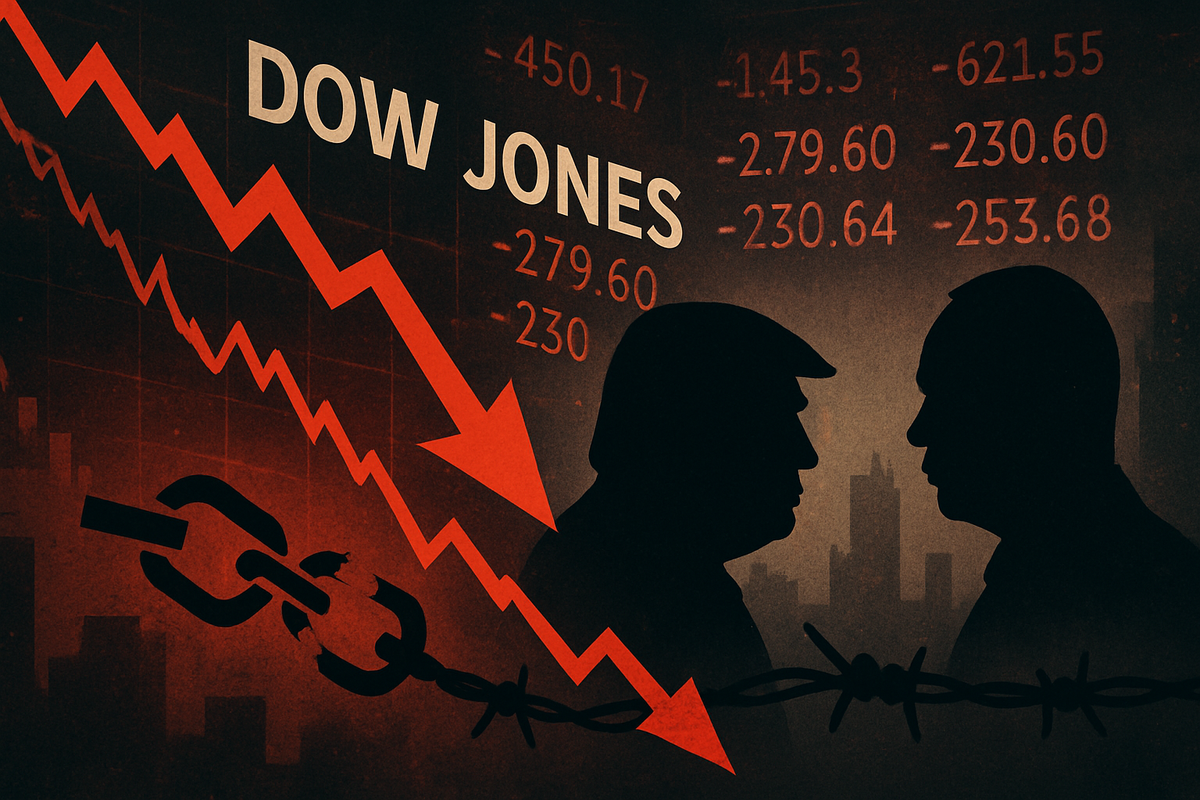
New trade war fears have sent shockwaves through global financial markets today, with the Dow Jones Industrial Average (DJIA) plummeting a staggering 500 points. The sharp decline reflects a palpable sense of apprehension among investors, who are grappling with the immediate implications of potential new tariffs and retaliatory measures. This sudden downturn signals a renewed period of market volatility and uncertainty, threatening to disrupt global supply chains, dampen corporate profits, and slow economic growth just as the world economy navigates a complex recovery path in late 2025.
The immediate reaction across trading floors was one of widespread anxiety and risk aversion. Investors quickly moved to offload riskier assets, leading to a broad-based sell-off that affected various sectors. This "flight-to-safety" mentality saw a surge in demand for traditional safe havens such as government bonds and gold, while export-oriented companies and those with complex international supply chains bore the brunt of the selling pressure. The sudden re-emergence of trade tensions has cast a long shadow over the economic outlook, raising concerns about inflationary pressures, disrupted global trade, and the potential for a significant dent in corporate earnings reports in the coming quarters.
The Spark: Renewed Tariff Threats Ignite Market Panic
The catalyst for today's dramatic market decline was an unexpected announcement from the White House, hinting at the imposition of new tariffs on a range of imported goods, primarily from a major Asian trading partner. While specific details remain scant, the administration cited concerns over alleged unfair trade practices and national security interests as the driving force behind the proposed measures. This development, occurring on October 10, 2025, caught many market participants off guard, as recent months had seen a period of relative calm on the trade front, leading to hopes that the more intense trade disputes of earlier years were largely behind us.
The timeline of events leading up to this moment began subtly, with increased rhetoric from government officials regarding industrial subsidies and intellectual property theft over the past few weeks. However, these statements were largely dismissed as posturing until a senior economic advisor, during an unscheduled press briefing yesterday, explicitly mentioned the "active consideration" of new punitive tariffs. This was followed by a leak to a prominent financial news outlet this morning, detailing potential targets for these tariffs, which include critical components for the technology sector, agricultural products, and certain manufactured goods. The official announcement, though not yet fully detailed, was enough to trigger a rapid sell-off as traders reacted to the prospect of immediate economic disruption.
Key players involved in this unfolding drama include the U.S. Trade Representative's Office, the Department of Commerce, and the National Economic Council, all of whom are reportedly crafting the specifics of the new trade policy. On the corporate side, multinational corporations with extensive global operations are bracing for impact, particularly those in the semiconductor, automotive, and consumer electronics industries. Initial market reactions were swift and severe: the Dow's 500-point drop was mirrored by significant declines in the S&P 500 (SPX) and Nasdaq Composite (IXIC), with technology stocks experiencing particularly sharp losses. Major indices across Asia and Europe also registered declines as the news rippled across time zones, highlighting the interconnectedness of the global economy and the far-reaching impact of trade disputes.
Companies on the Brink: Winners and Losers in a New Trade War
The resurgence of trade war fears promises to create a clear divide between potential winners and losers in the corporate landscape. Companies with extensive global supply chains, particularly those reliant on imports from the targeted regions, are immediately vulnerable. Technology giants like Apple Inc. (NASDAQ: AAPL) and Microsoft Corp. (NASDAQ: MSFT), which depend heavily on international manufacturing and component sourcing, could face increased production costs and disruptions. Similarly, automotive manufacturers such as General Motors Company (NYSE: GM) and Ford Motor Company (NYSE: F), already navigating complex supply chain issues, could see significant pressure on their margins due to higher tariffs on parts and raw materials. Retailers importing a wide array of consumer goods, including Walmart Inc. (NYSE: WMT) and Target Corporation (NYSE: TGT), might be forced to pass increased costs onto consumers, potentially dampening demand.
Conversely, certain sectors and companies might find themselves in a relatively advantageous position. Domestic manufacturers and producers, particularly those that compete with imported goods, could see an uptick in demand as tariffs make foreign products more expensive. Companies with robust domestic supply chains or those actively engaged in reshoring initiatives may experience increased market share. Furthermore, sectors focused on essential domestic services or infrastructure might be less affected by international trade tensions. For instance, utilities, domestic telecommunications providers, and certain healthcare companies could offer a degree of insulation from global trade shocks. The agricultural sector, however, presents a more complex picture; while some domestic producers might benefit from reduced foreign competition, others heavily reliant on export markets could suffer from retaliatory tariffs.
The ripple effects will also be felt in the financial sector. Investment banks like JPMorgan Chase & Co. (NYSE: JPM) and Goldman Sachs Group Inc. (NYSE: GS) could see increased volatility in trading volumes and a demand for hedging strategies, though overall market uncertainty might also deter new capital market activities. Companies involved in logistics and shipping, such as FedEx Corporation (NYSE: FDX) and United Parcel Service, Inc. (NYSE: UPS), could face significant operational challenges and fluctuating demand as trade routes are re-evaluated and supply chains shift. Furthermore, the semiconductor industry, with its intricate global web of design, manufacturing, and assembly, is particularly exposed. Companies like NVIDIA Corporation (NASDAQ: NVDA) and Intel Corporation (NASDAQ: INTC) could face disruptions in their ability to source critical components or sell their advanced chips in key markets, potentially impacting their ambitious growth trajectories in AI and other emerging technologies.
Broader Significance: A Return to Economic Nationalism?
This renewed escalation of trade tensions carries a wider significance that extends far beyond immediate market fluctuations, hinting at a potential return to more protectionist economic policies and a retreat from globalized trade. This event fits into a broader trend of increasing economic nationalism observed in various major economies over the past few years, driven by desires for supply chain resilience, national security concerns, and a perceived need to protect domestic industries and jobs. The current move by the U.S. administration could be interpreted as a strategic pivot towards greater economic self-reliance, even at the cost of short-term economic disruption and strained international relations.
The potential ripple effects on competitors and partners are substantial. Trading partners not directly targeted by the tariffs could still face indirect consequences as global supply chains reroute and commodity prices fluctuate. For instance, countries that serve as intermediate points in manufacturing processes might see reduced activity, while others could become alternative sourcing destinations, albeit with increased costs and logistical challenges. International organizations like the World Trade Organization (WTO) could find their authority further challenged as nations increasingly opt for unilateral trade actions. Regulatory and policy implications are also significant; governments worldwide may respond with their own protectionist measures, leading to a tit-for-tat tariff cycle that could spiral into a full-blown trade war, reminiscent of historical periods of economic conflict.
Historically, periods of escalating trade tensions have often been precursors to broader economic downturns. The trade disputes of 2018-2019, for example, led to significant market volatility, dampened business investment, and ultimately contributed to a slowdown in global economic growth. Comparisons can also be drawn to the Smoot-Hawley Tariff Act of 1930, which exacerbated the Great Depression by stifling international trade. While the current situation in October 2025 is different in its specifics, the underlying principle remains: trade barriers tend to harm global economic efficiency and foster an environment of uncertainty that discourages long-term investment and innovation. The current situation underscores the fragility of the interconnected global economy and the powerful impact that trade policy can have on market stability and prosperity.
What Comes Next: Navigating an Uncertain Economic Landscape
The immediate future following this renewed trade war scare is fraught with uncertainty, demanding careful navigation from businesses, investors, and policymakers alike. In the short term, markets are likely to remain highly volatile, sensitive to every official statement, rumor, or leak regarding the proposed tariffs. Investors should anticipate continued price swings and a heightened focus on corporate earnings reports, particularly from companies with significant international exposure. Businesses will be scrambling to assess the potential impact on their supply chains, seeking alternative suppliers or exploring options for reshoring production where feasible. Consumers, in turn, may face rising prices for imported goods, potentially impacting discretionary spending and overall economic activity.
Looking further ahead, the long-term possibilities depend heavily on the duration and intensity of these new trade tensions. A prolonged trade dispute could force significant strategic pivots for many multinational corporations, leading to a more fragmented global economy with regionalized supply chains. This could spur increased investment in automation and domestic manufacturing capabilities in some countries, while others might see a decline in foreign direct investment. Market opportunities may emerge for companies that can quickly adapt to new trade landscapes, offering solutions for supply chain resilience, domestic production, or innovative ways to mitigate tariff impacts. Conversely, companies unable to adapt or those heavily invested in now-disrupted trade routes face significant challenges to their profitability and long-term viability.
Potential scenarios range from a swift de-escalation, where the tariff threats serve as a negotiating tactic leading to a quick resolution, to a full-blown trade war with widespread tariffs and retaliatory measures. The latter scenario could lead to a global economic slowdown, increased inflation, and potentially even a recession. Policymakers will be under immense pressure to find a balance between protecting domestic interests and avoiding a damaging trade conflict. Investors should closely monitor diplomatic efforts, official announcements, and economic data releases for any signs of resolution or further escalation. The coming months will be critical in determining the trajectory of global trade and its profound impact on financial markets and the broader economy.
Comprehensive Wrap-Up: A Test of Resilience
Today's 500-point plunge in the Dow Jones Industrial Average, triggered by renewed trade war fears, serves as a stark reminder of the financial markets' sensitivity to geopolitical and economic policy shifts. The key takeaways from this event are clear: uncertainty breeds volatility, global supply chains remain vulnerable to protectionist policies, and the specter of inflation looms large when trade barriers are erected. This immediate market reaction underscores the interconnectedness of the global economy and how rapidly sentiment can shift based on perceived threats to free trade.
Moving forward, the market will undoubtedly be tested for its resilience. Investors should prepare for a period of sustained volatility and heightened risk. The focus will squarely be on how quickly and effectively governments can de-escalate tensions, or conversely, how businesses can adapt to a potentially more fragmented global trade environment. Companies with strong balance sheets, diversified supply chains, and a focus on domestic markets may fare better, while those with heavy reliance on international trade routes under threat could face significant headwinds.
The lasting impact of this event could be profound, potentially accelerating the trend towards regionalized trade blocs and reinforcing the importance of national economic security over pure globalization. What investors should watch for in the coming months includes official announcements regarding the specifics of any new tariffs, reactions from targeted trading partners, and any diplomatic efforts aimed at resolving the dispute. Furthermore, corporate earnings calls will provide crucial insights into how companies are adjusting their strategies and what the real-world impact of these trade tensions will be on their bottom lines. The next few quarters will undoubtedly be a defining period for global trade and investment.
This content is intended for informational purposes only and is not financial advice






